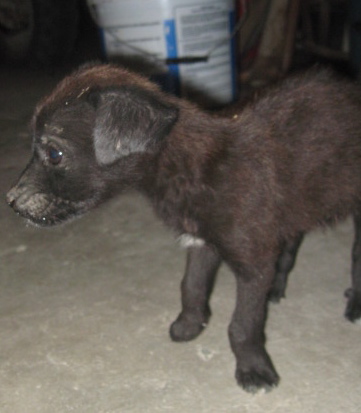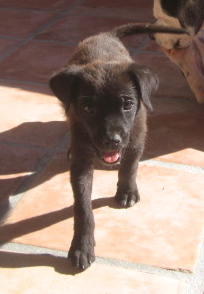A litter of eight puppies was born in Cabo Pulmo. One looked like Bravo, Ricardo’s brindle pit-bull, another like Charlie the rottweiler, one looked like Kiri, Juanito’s old golden retriever cross and so on. A clear example of the infidelity of dogs and that “littermate” does not translate to full brother or sister.Poon Poon was the handsome, sandy colored puppy apparently fathered by a beige pit bull owned by Señor Jesus Castro.
El Pelon (Baldy), as Jesus was known, lived with his blue-eyed wife Clotilde and their two children in what was the original ranch at the heart of Cabo Pulmo. He kept horses, chickens, cows and peacocks. And there were dogs for security and cats to keep the mice and rats at bay.
El Pelon was a locally renowned horseman, a
caballero or cowboy in the literal sense of the word. It is not without irony in the case of Pelon that
caballero also means “gentleman.”
Pelon adopted Poon Poon and presumably gave him his odd name, a common practice in this part of Mexico. Shortly thereafter, Poon Poon’s presumed father disappeared from the ranch and, when I asked one of the ranch hands where he was, they explained that Pelonprobably took him out to the dump and killed him. Pelon had done this before.
Out with the old, in with the new.
Like I said, while he may have been a horseman, a gentleman he was not.
Poon Poon grew into a big strapping, muscular dog. Despite his macho appearance, he was everyone’s friend and spent more time on the beach with tourists than he did at the ranch. He was a people dog and wanted to be where the action and attention was. Gradually he became the constant companion of one of the more gregarious dive instructors, Roger. As far as I could tell it was generally understood that Roger had formally adopted him.
Maturity and musculature, a sign of testosterone coursing in the veins, meant that Poon Poon became a fighter. Each time one of the village’s many female dogs came into heat, great dog fights were inevitable. Formidable adversaries in these fights were Bravo the pit bull and Charlie the Rottweiler. Even Kiri the old golden retriever would get his licks in where he could, but more often than not he came out on the losing side. Poon Poon typically returned from each battle with minor wounds, a scratch here, a puncture hole there, but one day I walked into the dive shop and was horrified to see him with large holes ripped into his neck.
“Wow Roger, those are serious wounds!”
“Ya, I know, but what can I do? He likes to fight.”
There was a spay and neuter clinic coming up and I was already taking two dogs to have them fixed. I figured it was worth a try.
“If he keeps up like this he’s going to get killed. That wound could have been fatal. You know he’s fighting over bitches don’t you? He’ll stop if you have him neutered. Why don’t you let me take him to the free clinic this week?”
The last line was said hopefully, but with the knowledge that most Mexican men abhor the idea of neutering a male dog. They see it as a direct reflection on their masculinity and as something unnatural, even sacrilegious.
To my surprise, Roger agreed. “Okay, do it. I don’t want him to fight any more.”
A couple of days later, Poon Poon, his brother Lobo, and a little black bitch named Nookie were loaded into the back of my truck and were off to Los Barriles and the free clinic.
The operation went off without a hitch and Poon Poon returned to Roger that evening showing little indication of the life-altering operation, his usual happy, energetic self despite the transformation his testicular sack had undergone, which now hung flaccid between his legs, empty as a poor man’s wallet. Roger’s eyes betrayed the regret and shame he felt for his dog. I asked him to keep the dog quiet and at home for the next 48 hours.
The next morning, as my tea steeped, there was a knock at the door. “Who could that be at this hour of the morning?” I thought.
At the door stood Clotilde, Pelon’s now widow. She looked perturbed, angry perhaps.
I began, “Buenos dias, Señora Clotilde,” but the words were barely out of my mouth before she cut in, “Can you please tell me who had my dog fixed?!”
Confusion. Shock. Misunderstanding because of my limited Spanish? No, I heard right.
“Your dog? Which dog?”
“Poon Poon.”
A very bright light illuminated above my head, a blindingly bright torch.
“Oooooh…Poon Poon?…uh, yes, um… I did…uh, Roger gave me permission.”
At the mention of Roger’s name, her eyebrows shot skywards and she replied “That is what I thought!” She spun on her heel and strode away. For a second I thought, “Is that it? Aren’t you going to yell at me?” But then I realized she was reserving her wrath for Roger. I tried to intervene.
“No wait! Clotilde. Why are you angry?”
She turned to listen, her blue eyes cold as steel. I continued, “Didn’t you see the wounds on his neck? He was going to get killed. Now he won’t fight with the other dogs.”
Lifting her head high, she glared down her nose and revealed my ignorance, “No! Now he will be lazy and wander. And he will not protect the property. He is ruined!”
I tried to explain that he would stay closer to home now and be a better watch dog, but she had made up her mind. She shook her head, turned, and headed off, a woman on a mission.
“Oh God! Roger! She’ll be on the war path for him and out for his manhood!” I gulped down my tea and ran to the dive shop to warn Roger.
His downcast face told me I was too late. We shrugged it off, recognizing there was no going back, comforted by the knowledge that Poon Poon was better off.
A little later that same day, as I bicycled past the ranch, a curious sight caught my attention; Six Mexican caballeros dressed in jeans, cotton shirts and cowboy boots, some in white cowboy hats, stood in a loose circle, with hands cupping chins thoughtfully, attention directed at something on the ground. They wore serious expressions – disappointment, pity, maybe shame. Some heads shook disapprovingly. Then as I rounded the corner, the focus of their attention came into view. It was Poon Poon. There he lay, on his back, in the middle of their circle, tail wagging contentedly, begging for a belly rub, innocently exhibiting to all present what was evidently considered his shame.
**************************************
Thousands of innocent animals are killed every day because of uncontrolled animal breeding. Click here to donate to PETA’s SNIP program.
Please click here to donate food to abandoned animals.
 Our dog Zee is going blind. The vet informed me that she has glaucoma and an auto-immune disease that’s making her body attack itself. Yes, not one, but two diseases affecting her eyes. One at a time, her eyes swelled up into big, bulbous, blood shot orbs with milky irises at their centers. The first to swell then shrank to a fraction of its size, sank back into its orbit, where it now sits wrinkled like a raisin and useless as the tit on a boar. Then the left eye followed suit and blew up to twice its normal size. We’d already taken her to the vet for the right eye, so when the left started expanding I squeezed in the same drops and shuttled her off to the vet with great trepidation – I knew that the news would not be good. He kept her for observation for three…
Our dog Zee is going blind. The vet informed me that she has glaucoma and an auto-immune disease that’s making her body attack itself. Yes, not one, but two diseases affecting her eyes. One at a time, her eyes swelled up into big, bulbous, blood shot orbs with milky irises at their centers. The first to swell then shrank to a fraction of its size, sank back into its orbit, where it now sits wrinkled like a raisin and useless as the tit on a boar. Then the left eye followed suit and blew up to twice its normal size. We’d already taken her to the vet for the right eye, so when the left started expanding I squeezed in the same drops and shuttled her off to the vet with great trepidation – I knew that the news would not be good. He kept her for observation for three…















